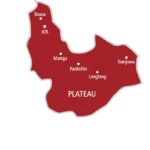One of the pervasive plants that greet anyone stepping or driving into some communities in Plateau State is cactus. Cactus is known for its thick, fleshy but prickly stems, spines and branches. It can adapt to both dry and hot climates by storing water in its stems.
The plant, which serves as decoration in homes and gardens, is also said to possess medicinal properties. Some cactus species are said to contain compounds that can be used to treat a variety of ailments.
Cactus are so widespread and imposing that most of those who visit some of the communities in the ‘Centre of Peace and Tourism’, often marvel at the love and care given to the plant by the members.
The cactus are mostly found in Jos-south, Riyom, Jos-north, Barkin Ladi and Bokkos Local Government Areas of the state, where they can be seen around houses, on the sides of streets, around farms and other places. And while others say it is used to demarcate their houses or lands to help in marking their boundaries from those of others, several others say they cultivate it just for the love of the plant.
- Largest diamond in over a century discovered in Botswana
- Why Nigeria must embrace Tsangaya education system
Weekend Trust gathered that one of the most prominent reasons for the adoption and use of the cactus plants is protection, and this dates back to the olden days, especially among the Berom people of the state. A Berom man from Jos-South Local Government Area, Barrister Benjamin Davou, said the people found solace and protection in cacti during the territorial wars, when they found out its protective ability. He said they weren’t affected during the battles.
“The cactus we are talking about is a symbol of security and defense; that is why, to date, you see Berom people putting them around their houses. If you see an old one, it is mostly very high with so many branches, and it serves as a barrier against intruders. That is why we still hold it firmly. Though, some people think there are other spiritual reasons for the attachment to the plant, I do not know anything about that. Cactus use has been passed from generation to generation; it was passed down to us from our fathers and our forefathers. And that’s how we knew about it.
“Most trees you see around here have their uses, and when you discover the uses, and probably you decide to put them to certain use and it works for you, that is when you bring them close to you. I believe that is how the cactus came about in Berom land. If you go to other parts of the world like the United States of America, there is specie of cactus that grows there, but we have brought our own particular cactus closer to us to make it a part of our life for security purpose.
“Like I said when it grows big that is when you will see its importance and you will find out that it has branches. It is not something you can pull down easily. For you to pull it down, you must put a lot of energy into it. Another feature is that it is thorny and those thorns can serve the purpose of security that we are talking about. Therefore, the cactus has been a symbol of the Berom nation as represented on our logo. The plant represents strength and protection to the Berom people.
“Another thing that makes the cactus dangerous is that it has a whitish fluid that can cause blindness when it comes in contact with the eye. Also, if it touches the skin it can cause other infections. But we, the owners and users know how to maneuver around them, which gives us an advantage over intruders or trespassers,” he said.
Another Berom man, Luka Zang, said they use the cacti as a barrier to map out boundaries for their houses or landed properties, just as it serves as a good security measure for them. He noted that it is very difficult to pass through the cactus plant.
“The cactus is of traditional significance to the Berom people and it’s mostly used as security because if you use it as a fence, it is difficult for an intruder to pass through it. The cactus is so significant that it is featured on the Berom peoples’ logo. Asides that, it is widely used as a fencing material, whereby we fence our houses with it instead of using blocks/bricks or other objects,” he said.
How to plant it
Weekly Trust gathered that the planting is done using the stem and not seed.
A source said, “You cut the stem into different lengths, then you plant it, and in planting them, we do that by crossing them with each other so that when they grow, they grow into one another, thereby forming a formidable clog that makes it impossible for intruders to pass in-between them.”
An indigene of Plateau, who is from Shendam Local Government Area and Gamai by tribe, Moses Bityen, said he uses cactus plants in his house, adding that he used it to fence his house to protect his plants from animals, and to demarcate his land.
“The main reason for using cactus for me is fencing; that is if you don’t have the capacity to make a structure or to build the fence, you can make use of it. It always shows that a particular place is owned by a certain person, and by extension it is used for security reasons.
“People don’t jump over it because of its thorns, and if you try cutting it down it has a liquid content which is dangerous,” he said.
A man from Bayelsa State, Jonathan Ibioyebo, who came on a missionary assignment and outreach for tackling drug abuse, cultism and other antisocial vices among youths in Plateau communities, said they don’t have such plants in their area and that he started seeing them in their numbers since coming to Plateau State.
He said he saw them used as fences round houses, adding that the plant fascinates him.
Gyang Dalyop Pwol, who is the Da Maje of Garasan community of Rantiya in Jos, also spoke on the plant.
He said the cactus, which is a symbol in the Berom tradition is one of the plants created by God and that because Berom people at the initial stage were mostly hunters and farmers, the cactus became a symbol that reflected their heritage.
“Cactus is very unique in its nature as given by God. We use it to demarcate our parcels of land. For instance, when parents share their lands among their children, cactus is used in the demarcation.
“So, I want to say that cactus is of great importance to the Berom people and we have benefited a lot in terms of securing our environment. And you don’t touch it anyhow because there are certain traditional values you must abide by,” he said.

 Join Daily Trust WhatsApp Community For Quick Access To News and Happenings Around You.
Join Daily Trust WhatsApp Community For Quick Access To News and Happenings Around You.


